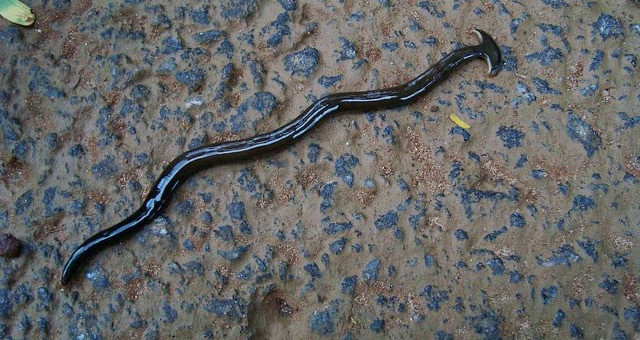What is a hammerhead worm? What are the characteristics of the hammerhead worm? Let's find out together!

A man named Danish Ho from the state of Johor in southern Malaysia discovered this strange creature. Mr. Danish Ho thought he had discovered a new species of snake because he had never seen such a creature before.
This scary “monster” is actually a hammerhead worm, a type of flatworm, belonging to the Geoplanidae family. This is the largest worm ever recorded in the world. When mature, their bodies can be up to 60cm long, causing many people to mistake them for snakes.
The video captures a terrifying image of a creature with a scary appearance that looks like it came out of a science fiction movie.
Information you need to know about hammerhead worms
- Scientific name: Bipalium sp.
- Other names: Broad-headed flatworm, “landchovy”
- Distinguishing features: Large terrestrial flatworms with hammer-shaped heads and gastropods or “cow soles”
- Size range: From 5 cm (B. adventitium) to more than 20 cm in length (B. kewense)
- Diet: Carnivorous, known to eat earthworms and each other
- Longevity: Potentially immortal
- Habitat: Distributed worldwide, prefers moist, warm habitats
- Conservation status: Not assessed
- Gender: Animals
- Phylum: Platyhelminthes
- Class: Rhabditophora
- Order: Tricladida
- Family: Geoplanidae
- Fun fact: The hammerhead worm is one of the very few terrestrial invertebrates known to produce the neurotoxin tetrodotoxin.
The most prominent features of hammerhead worms are their fan-shaped or hammer-shaped heads and long, flattened bodies. The underside of the flatworm has a large “crawling sole” used for movement. Species are distinguished by head shape, size, color and stripe pattern.
The hammerhead worm is carnivorous, and is considered a dangerous invasive species in the US and Europe. They come in many different shapes, sizes and colors.
Hammerhead worms hunt by secreting a sticky substance, making the victim unable to move. Then, it uses enzymes to melt its prey into water and absorb this liquid nutrient into its body.

Their main food is earthworms, snails and insects. If they cannot hunt their prey, the hammerhead worm eats itself and then regenerates in a short time.
The method of reproduction of hammerhead worms is also very diverse, some species can lay eggs while others just need to divide their bodies in half. Once divided, the rear segment can move immediately and after a few days a new head will grow. In a month, hammerhead worms reproduce asexually several times.

According to research by scientists, hammerhead worms have no respiratory system, no bone structure, no circulatory system and the mouth can play a role similar to the anus.


